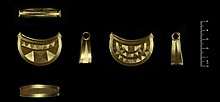Shropshire bulla
The Shropshire bulla (Medieval Latin for "a round seal", Classical Latin for "bubble, blob", plural bullae) is a Late Bronze Age gold pendant found by a metal detectorist in 2018 in Shropshire, England. Made primarily of gold, it is the eighth bulla discovered to date in Britain and Ireland, and only the second in Britain. The pendant, decorated with intricately carved geometric designs, is now in the British Museum in London.
| Shropshire bulla | |
|---|---|
 Shropshire bulla, different views | |
| Material | Gold, silver, copper |
| Size | Height: 36 mm, width: 47.4mm |
| Created | 1000 BC – 750 BC |
| Period/culture | Late Bronze Age |
| Discovered | May 12, 2018 Shropshire, England |
| Present location | British Museum |
According to the Portable Antiquities Scheme, "The workmanship of the construction and decoration of the 'Shropshire Marches' bulla represents the highest skill and expertise seen within decorated metalwork of the period being almost un-paralleled within a British context."[1]
The findspot has been kept secret, called only the "Shropshire Marches",[1] that is to say the west side of Shropshire, forming part of the Welsh Marches along the border with Wales.
Description
The Shropshire bulla is a D-shaped hollow object created from pieces of gold sheet metal by a highly skilled craftsman.[2] Named after amulets worn in Roman Europe, bullae were most likely worn as pendants. The Shropshire bulla is an example of "reversible fashion"; the front and back are alike in design, either side can be selected to be the presenting face. Bullae were probably highly prized adornments, worn as clothing accessories to display the wearer's high status and wealth.[3] [4]
The Shropshire pendant is decorated with an intricately carved geometric design, embellished with tiny triangles consisiting of evenly spaced diagonal lines. Analysis of the bulla reveals that the surface is composed of 79—81% gold, 14—16% silver with the remaining being copper. The dimensions of the object are: width, 47.4 mm (1.87 in); height, 36.7 mm (1.44 in); and weight, 26.6 g (0.94 oz); [1]
History
In May 2018, the Shropshire Finds Liaison Officer, Peter Reavill, received a phone call from a metal detectorist who had discovered a spectacular find. The name of the landowner and metal detectorist, and the location, are unnamed to protect the findspot and potential archaeological artefacts.[2] In viewing photographs of the intricately carved, gold pendant, Reavill's first thought was that the pendant was the missing Irwell bulla, which had been found in the Manchester Ship Canal in 1772. That bulla was eventually sold at auction in 1806 and has since disappeared. After further evaluation, Reavell concluded that the new find was not the missing bulla.[4]
The Shropshire bulla is only the second bulla to be discovered in England and the eighth bulla found to date in Britain and Ireland. This artefact is the most south-westerly example of high-quality Late British Bronze Age gold metalwork production and deposition. The find indicates the existence of rich mineral deposits in this region of Britain.[1] The pendant has been described by the British Museum as "one of the most significant pieces of Bronze Age gold metalwork" ever discovered in Britain.[5] It is currently at the British Museum where is it being analyzed by the Department of Scientific Research and Neil Wilkin, museum curator of the European Bronze Age.[4]
References
- "BULLA". Portable Antiquities Scheme. Retrieved 19 January 2020.
- "Rare Bronze Age Gold Bulla declared as treasure". Shropshire.gov. Retrieved 21 January 2020.
- "Bulla". National Museum of Ireland. Archived from the original on 18 August 2013. Retrieved 21 January 2020.
- "The Shropshire bulla: Bronze Age beauty and a mystery from Manchester". Current Archaeology. Retrieved 19 January 2020.
- "Shropshire Bronze Age gold pendant 'amazingly rare'". BBC. Retrieved 21 January 2020.